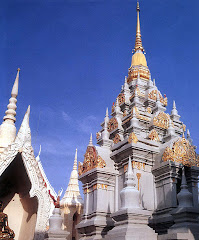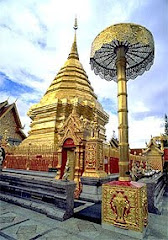Introduction
There are thousands of temples, or wat, in Thailand. Some of these vary in style and size but according to the principles of Buddhist architecture, the structures within a temple should include a bot, or ubosot, for religious ceremonies such as ordinations; a wihan to house various Buddha images and for laypersons to take part in religious services;
A Sala kanparien which is a large meeting hall which is not only used for religious services but also sometimes as a social or civic center; a mondop for storing the Buddhist scriptures; chedi for housing sacred relics or images; a ho rakang, or belfry, to sound the time for ceremonies, prayers, etc. and kuti where the monks live. Some may also have a library, a crematorium and a school.
Wat : A Wat is a Thai Buddhist temple or monastery. In most cases it is not just one building, but a collection of buildings, shrines, and monuments within a courtyard that is enclosed by a wall.
The Bot : The Bot (also called Ubosot) is the ordination hall of a Wat. It is the place where new monks take their vows. You can recognize a building as a Bot by the six boundary stones (Bai Sema) that define the limits of its sanctuary. Bots are usually open only to the monks. The building faces east and usually houses an altar and one or several Buddha images. The hornlike finial on the roof ridge is called the chofa, representing the head of the garuda.
Chofah : Chofahs are the bird-like decorations on the end of the temple roofs.
 Chedi : A Chedi (a different term would be stupa or pagoda) is a domed edifice, often quite tall, under which relics of the Buddha or revered religious teachers are buried.
Chedi : A Chedi (a different term would be stupa or pagoda) is a domed edifice, often quite tall, under which relics of the Buddha or revered religious teachers are buried.
 Prang : A Prang is an Ayutthayan or Khmer-style Chedi that is high and slim and looks like a vertical ear corn.Many of the Chedis in Wat Phra Kaew or Wat Po in Bangkok are Prangs.
Prang : A Prang is an Ayutthayan or Khmer-style Chedi that is high and slim and looks like a vertical ear corn.Many of the Chedis in Wat Phra Kaew or Wat Po in Bangkok are Prangs.source: ekohchang.com
Photo: thaiwebsites.com
technorati Tags: Buddhist temples/temple/Thai temple/Thailand temple/Wat









No comments:
Post a Comment